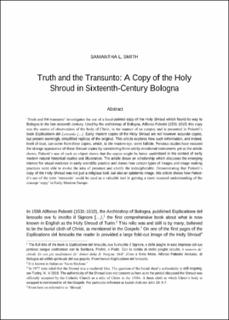Truth and the 'Transunto': a copy of the Holy Shroud in Sixteenth-Century Bologna
Journal article, Peer reviewed
Published version

Åpne
Permanent lenke
https://hdl.handle.net/11250/2834426Utgivelsesdato
2021Metadata
Vis full innførselSamlinger
Originalversjon
Acta ad archaeologiam et artium historiam pertinentia. 2021, 32 (18), 59-80 10.5617/acta.9019Sammendrag
'Truth and the transunto' investigates the use of a hand-painted copy of the Holy Shroud which found its way to Bologna in the late sixteenth century. Used by the archbishop of Bologna, Alfonso Paleotti (1531-1610), this copy was the source of observations of the body of Christ, in the manner of an autopsy and is presented in Paleotti's book Esplicatione del Lenzuolo [...]. Early modern copies of the Holy Shroud are not however accurate copies, but present seemingly simplified replicas of the original. This article explores how such information, and indeed, level of trust, can come from these copies, which, to the modern eye, seem fallible. Previous studies have excused the strange appearance of these Shroud copies by considering them solely devotional instruments yet as the article shows, Paleotti's use of such an object shows that the copies might be better understood in the context of early modern natural historical studies and illustrations. The article draws on scholarship which discusses the emerging interest for visual evidence in early scientific practice and shows how certain types of images and image-making practices were able to evoke the idea of presence and clarify the indecipherable. Demonstrating that Paleotti's copy of the Holy Shroud was not just a religious tool, but also an epistemic image, this article shows how Paleotti's use of the term 'transunto' could be used as a valuable tool in gaining a more nuanced understanding of the concept 'copy' in Early Modern Europe.
